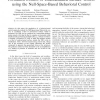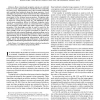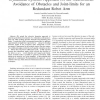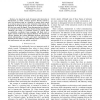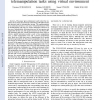IROS
2006
IEEE
14 years 5 months ago
2006
IEEE
— In this paper the application of a behavior-based control approach, namely the Null-Space-based Behavioral control, to coordinate a fleet of autonomous surface vessels is pres...
IROS
2006
IEEE
14 years 5 months ago
2006
IEEE
— This paper deals with the motion of a multi-legged modular robot. The robot consists of six homogenous modules, each of which has a body and two legs and is connected to the ot...
IROS
2006
IEEE
14 years 5 months ago
2006
IEEE
– Motion synchronization in mobile robot networks is a fundamental task in distributed multi-robot collaboration. In this paper, we investigate the robustness of synchronous spee...
IROS
2006
IEEE
14 years 5 months ago
2006
IEEE
—Many vision-based navigation systems are restricted to the use of only a limited number of landmarks when computing the camera pose. This limitation is due to the overhead of de...
IROS
2006
IEEE
14 years 5 months ago
2006
IEEE
The increasing number of launched satellites per year, calls for solutions to keep free operational space for telecommunication systems in geo-synchronized orbit, as well as to av...
IROS
2006
IEEE
14 years 5 months ago
2006
IEEE
— We extend the attractor dynamics approach to generate goal-directed movement of a redundant, anthropomorphic arm while avoiding dynamic obstacles and respecting joint limits. T...
IROS
2006
IEEE
14 years 5 months ago
2006
IEEE
IROS
2006
IEEE
14 years 5 months ago
2006
IEEE
IROS
2006
IEEE
14 years 5 months ago
2006
IEEE
— An important mode of human-robot interaction is teleoperation, in which a human operator directly controls a robot via hardware such as a joystick or mouse. Such control is not...
IROS
2006
IEEE
14 years 5 months ago
2006
IEEE
Abstract— This paper gives preliminary results about the utilization of an interaction technique called FOLLOW-ME to fasten the selection task for teleoperation system. The imple...
